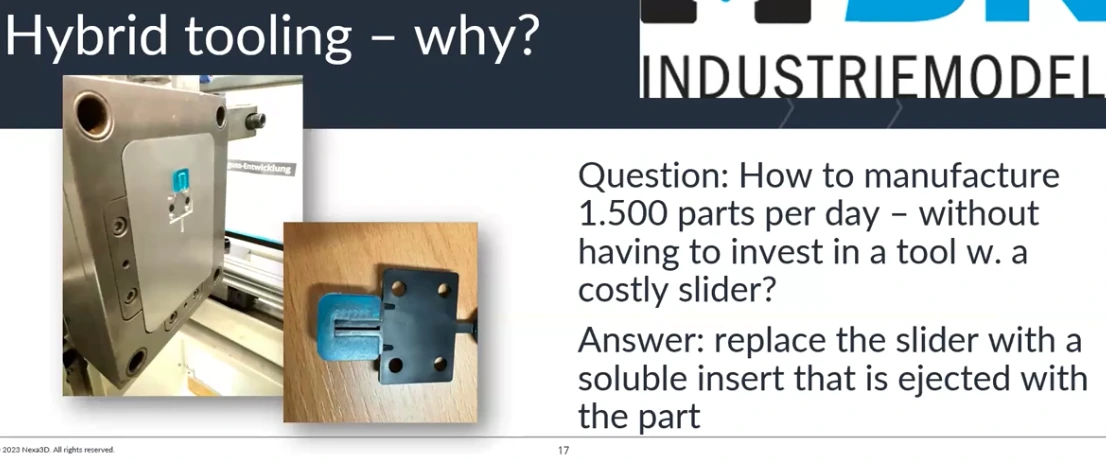When deciding whether to opt for a production mold (typically in steel) or a prototype mold to enable you to validate and test your plastic parts, it’s crucial to weigh the pros and cons. A prototype mold offers a more cost-effective and flexible solution, especially for projects in development or the very early stages of production, where large volumes aren’t yet needed.
However, the question remains: is a prototype mold right for you?
What is a Prototype Mold?
A prototype mold is a temporary mold, often made of soft steel, silicone, or 3D-printed resins, that allows for limited production runs. It’s an ideal solution for businesses looking to test and validate their plastic part designs before committing to the higher costs and longer lead times of a production mold, typically made from hard steel.
According to Boston Micro Fabrication (BMF), the setup costs of traditional injection molding productions largely come from the tooling, typically hard steel molds. Using prototype molds, on the other hand, “eliminates these costs and the variability that comes with them.”
When Does a Prototype Mold Make Sense?
Typical prototype molds, for instance, made from silicone, are best suited for projects where the part design doesn’t have to meet tight tolerances or aesthetic standards. For example, if a little surface flash is acceptable, or the parts don’t need to have a perfect fit, using a prototype mold can save you time and money. In some cases, assembly processes, like gluing, may be necessary to compensate for the less precise fit.
However, it’s essential to note that the cost savings on a prototype mold can be significant compared to a high-quality steel mold. Though, as noted in the Autodesk Fusion Blog, while 3D printing is more affordable for prototyping, the savings may not always justify the trade-offs in durability and precision when moving into full production.
How about side actions within the mold?
A big limitation of all forms of prototype tooling we have seen so far is the lack of side actions. If the part needs sliders, lifters, or other special actions within the mold, that’s an issue.
For a small run or a bridge production run, that might be acceptable. Instead of parts that snap into place neatly, you may need to use glue. You may have to do a bit of drilling or other forms of secondary processing. It very much depends on the part geometry…
3D Printing molds is always faster than traditional machining
Recent advancements in 3D printing technology have changed the game for prototype molds. So-called ‘freeform injection molding’ technology does allow use of production intent materials as well as demolding (by dissolving a part of the mold if needed!).
It can also be used in hybrid tooling, which combines traditional molds with 3D-printed components, which is a good answer to certain needs — typically for bridge production runs.

(Image courtesy of Nexa3D)
For example, the image above shows how a soluble insert can replace an expensive slider, allowing for up to 1,500 parts to be produced per day without requiring complex tooling. After each part has been ejected, the 3D-printed insert can be dissolved in a bath leaving just the required part.
In All3DP Pro’s Guide, they highlight that “3D-printed molds are especially useful for low-volume production and rapid prototyping,” noting that this approach can significantly reduce lead times by cutting out the need for machining or modifying a traditional mold. Instead of weeks or months, businesses can produce and test parts made with production-intent materials and created in an injection mold press in days!
Creative Solutions for Short-Run Production
For businesses that need flexibility without committing to a full production mold, prototype molds provide an innovative solution. As highlighted by All3DPPro, 3D printing enables “greater design freedom” than traditional molding techniques, allowing you to test intricate and complex designs without the constraints of costly tooling. Additionally, hybrid approaches—like soluble inserts or 3D-printed cores—allow for higher output with a much faster setup, as illustrated in the image above.
Conclusion: Is a Prototype Mold Right for You?
If you’re still in product development, a prototype mold can be the perfect fit for your business. It offers the flexibility to test designs quickly, make adjustments, and avoid the high upfront costs associated with steel production molds. However, when your plastic parts need to meet stringent standards or will be produced in large volumes, a hard steel mold will provide better long-term value.
By using cutting-edge technologies like 3D-printed and soluble molds or the right type of hybrid tooling, some businesses manage to strike a balance between cost, speed, and quality that makes sense in their situations.
Learn more about our plastic production services and get in touch to discuss your project here.



